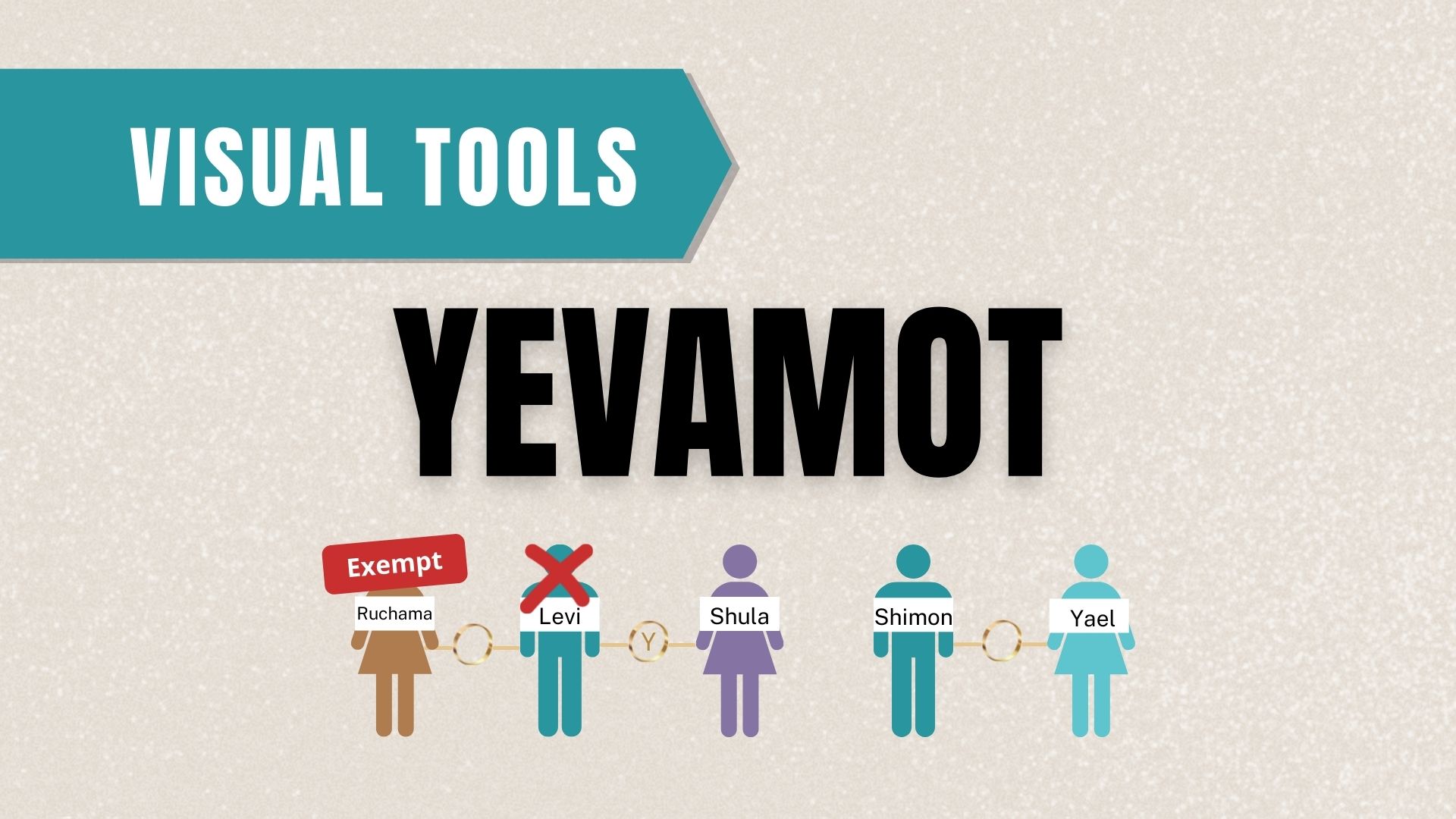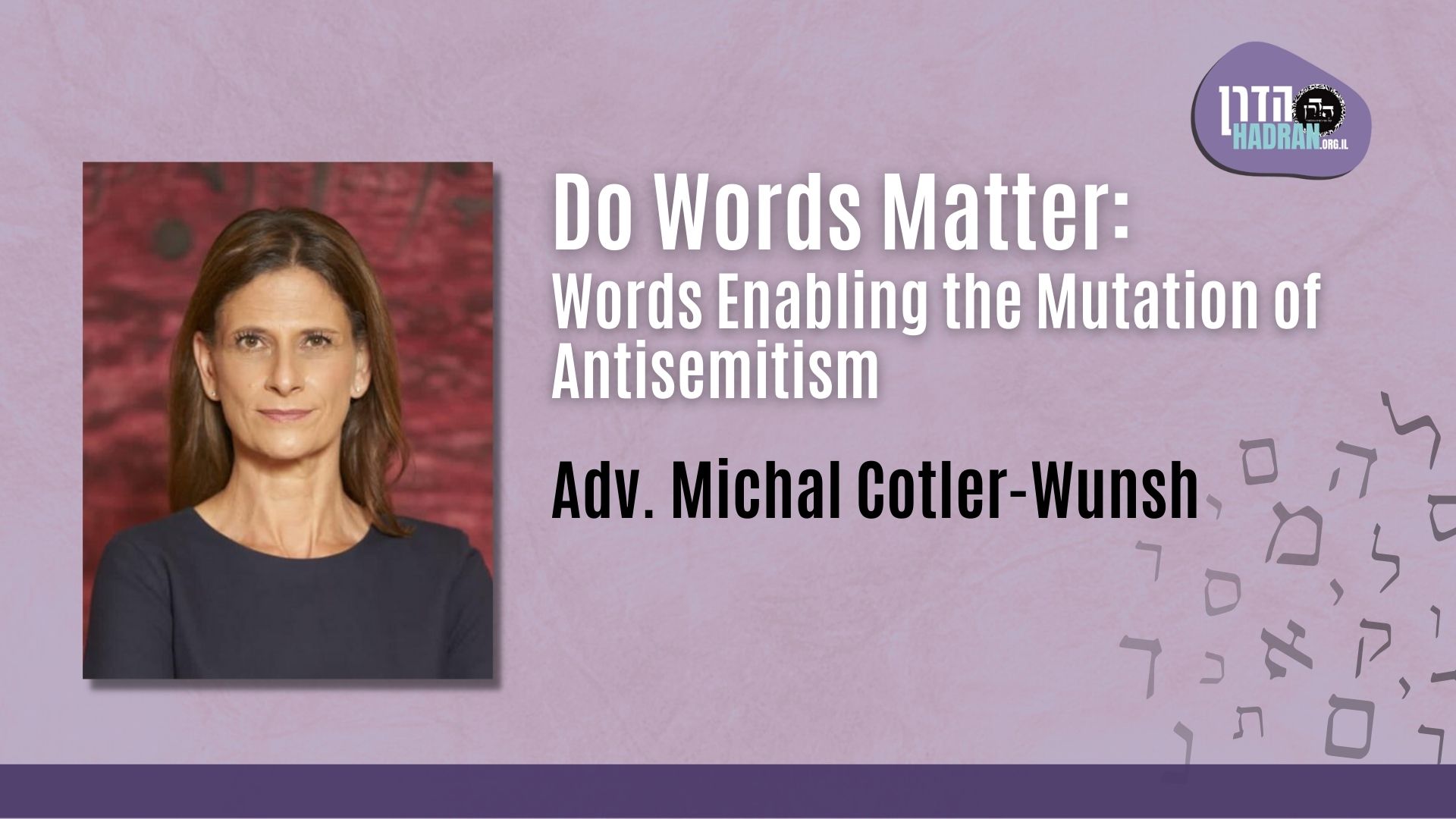This week’s learning is sponsored by Caroline Bollag l’ilui nishmat Pinchas ben Menashe Peyser.
Want to dedicate learning? Get started here:


Today’s daily daf tools:
This week’s learning is sponsored by Caroline Bollag l’ilui nishmat Pinchas ben Menashe Peyser.
Today’s daily daf tools:
Delve Deeper
Broaden your understanding of the topics on this daf with classes and podcasts from top women Talmud scholars.
New to Talmud?
Check out our resources designed to help you navigate a page of Talmud – and study at the pace, level and style that fits you.
The Hadran Women’s Tapestry
Meet the diverse women learning Gemara at Hadran and hear their stories.
Bekhorot 26
הָא בַּעַל מוּם שְׁרֵי, אַף עַל פִּי שֶׁלֹּא הִתִּירוּ מוּמְחֶה! תַּנָּא: כֹּל הֵיכָא דְּלֹא הִתִּירוֹ מוּמְחֶה — תָּם קָרֵי לֵיהּ.
But in the case of a blemished firstborn, use of its wool is permitted, even though an expert did not deem the animal permitted for slaughter. This contradicts the statement of Rabbi Asi. The Gemara answers: It is possible that the tanna of that baraita calls the animal unblemished wherever an expert did not yet deem the firstborn permitted for slaughter, even if it was physically blemished.
לֵימָא כְּתַנָּאֵי: הַתּוֹלֵשׁ צֶמֶר מִבְּכוֹר תָּם, אַף עַל פִּי שֶׁנּוֹלַד בּוֹ מוּם וּשְׁחָטוֹ — אָסוּר. בְּכוֹר בַּעַל מוּם שֶׁתָּלַשׁ מִמֶּנּוּ, וְאַחַר כָּךְ מֵת — עֲקַבְיָא בֶּן מַהֲלַלְאֵל מַתִּיר, וַחֲכָמִים אוֹסְרִים. אָמַר רַבִּי יְהוּדָה: לֹא בָּזֶה הִתִּיר עֲקַבְיָא בֶּן מַהֲלַלְאֵל, אֶלָּא בִּשְׂעַר בְּכוֹר בַּעַל מוּם שֶׁנָּשַׁר וְהִנִּיחוֹ בַּחַלּוֹן, וְאַחַר כָּךְ שְׁחָטוֹ — בָּזֶה עֲקַבְיָא בֶּן מַהֲלַלְאֵל מַתִּיר, וַחֲכָמִים אוֹסְרִין.
The Gemara remarks: Let us say that the interpretation of Reish Lakish is the subject of a dispute between tanna’im, as the baraita states: With regard to one who plucks the wool from an unblemished firstborn, even though it later developed a blemish and the owner slaughtered it, use of the wool is prohibited. In the case of a blemished firstborn from which one plucked wool, and it subsequently died, Akavya ben Mahalalel deems the wool permitted and the Rabbis deem it prohibited. Rabbi Yehuda said: It was not with regard to that case that Akavya ben Mahalalel deemed use of the wool permitted. Rather, it was in a case of the hair of a blemished firstborn animal that shed from the animal and one placed the hair in a compartment, and thereafter one slaughtered the animal. In that case Akavya ben Mahalalel deems use of the wool permitted, and the Rabbis deem its use prohibited.
אָמַר רַבִּי יוֹסֵי: מוֹדֶה אַבָּא חֲלַפְתָּא בְּזֶה שֶׁהוּא מוּתָּר, אֲבָל בְּיִיחוּד אָמְרוּ חֲכָמִים: יַנִּיחֶנּוּ בַּחַלּוֹן, שֶׁמָּא יֵשׁ תִּקְוָה. שְׁחָטוֹ — דִּבְרֵי הַכֹּל מוּתָּר, מֵת — עֲקַבְיָא בֶּן מַהֲלַלְאֵל מַתִּיר וַחֲכָמִים אוֹסְרִים.
The baraita continues: Rabbi Yosei says: My father, Ḥalafta, concedes to Akavya ben Mahalalel in this case of a slaughtered firstborn that use of the wool is permitted. Indeed [aval], the Rabbis said explicitly: One places it in a compartment, as perhaps there is a hope that use of the wool will ultimately be permitted, since if he slaughters the animal all agree that use of the wool is permitted. But if the animal dies by other means, Akavya ben Mahalalel deems use of the wool permitted and the Rabbis deem it prohibited.
רַבִּי יוֹסֵי — הַיְינוּ תַּנָּא קַמָּא! אֶלָּא לָאו הִתִּירוֹ מוּמְחֶה אִיכָּא בֵּינַיְיהוּ?
The Gemara raises a difficulty: If that is the explanation of their dispute, the opinion of Rabbi Yosei is identical to the opinion of the first tanna in the baraita, as both hold that use of the wool of a slaughtered blemished firstborn is permitted and the dispute between Akavya ben Mahalalel and the Rabbis applies to a case where the animal dies by other means. Rather, is it not correct to say the dispute between them concerns the requirement that an expert deem the animal permitted for slaughter?
דְּתַנָּא קַמָּא סָבַר: הִתִּירוֹ מוּמְחֶה — אִין, וְאִי לָא — לָא, וַאֲתָא רַבִּי יוֹסֵי לְמֵימַר: אַף עַל גַּב דְּלֹא הִתִּירוֹ מוּמְחֶה!
The Gemara elaborates: As the first tanna holds: If an expert deemed the animal permitted before its wool was shed, then yes, use of the wool is permitted after the animal has been slaughtered; but if not, then use of the wool is not permitted. And Rabbi Yosei comes to say that even in a case where an expert did not deem the firstborn permitted for slaughter before its wool was shed, use of the wool is still permitted. If so, the interpretation of Reish Lakish is the subject of the dispute between the first tanna and Rabbi Yosei: The first tanna agrees with that opinion and Rabbi Yosei rejects it.
אָמַר רָבָא: לָא, דְּכוּלֵּי עָלְמָא אִי הִתִּירוֹ מוּמְחֶה — אִין, אִי לֹא הִתִּירוֹ — לָא, וְשָׁלֹשׁ מַחְלוֹקוֹת בַּדָּבָר, דְּתַנָּא קַמָּא סָבַר: פְּלִיגִי בְּמֵת, וְהוּא הַדִּין לִשְׁחָטוֹ, וְהַאי דְּקָמִיפַּלְגִי בְּמֵת — לְהוֹדִיעֲךָ כֹּחוֹ דַּעֲקַבְיָא.
Rava said: No, the interpretation of Reish Lakish is not the subject of their dispute, as everyone agrees that if an expert deemed the animal permitted before its wool was shed, then yes, use of the wool is permitted, but if an expert did not deem the animal permitted beforehand then the use of its wool is not permitted. And there are three disputes concerning this matter, as the first tanna holds: Akavya ben Mahalalel and the Rabbis disagree with regard to a case where the firstborn died, and the same is true, i.e., they disagree, in a case where he slaughtered it. And the reason that the first tanna states they disagree specifically in a case where it died is to convey to you the far-reaching nature of the opinion of Akavya, i.e., that he deems use of the wool permitted even if the animal was not slaughtered.
וְרַבִּי יְהוּדָה סָבַר: בְּמֵת — דִּבְרֵי הַכֹּל אָסוּר, כִּי פְּלִיגִי — בִּשְׁחָטוֹ, וַאֲתָא רַבִּי יוֹסֵי לְמֵימַר: בִּשְׁחָטוֹ — דִּבְרֵי הַכֹּל מוּתָּר, כִּי פְּלִיגִי — בְּמֵת.
And Rabbi Yehuda holds: With regard to a firstborn that died, all, i.e., Akavya ben Mahalalel and the Rabbis, agree that use of the wool is prohibited, and when they disagree it is with regard to a case where the owner slaughtered the animal. And Rabbi Yosei comes to say: Where he slaughtered it, all agree that use of the wool is permitted, and when they disagree it is with regard to a case where the animal died.
אָמַר רַב נַחְמָן: הֲלָכָה כְּרַבִּי יְהוּדָה, הוֹאִיל וּתְנַן בִּבְחִירָתָא כְּוָותֵיהּ, דִּתְנַן: שְׂעַר בְּכוֹר בַּעַל מוּם שֶׁנָּשַׁר וְהִנִּיחוֹ בַּחַלּוֹן, וְאַחַר כָּךְ שְׁחָטוֹ — עֲקַבְיָא בֶּן מַהֲלַלְאֵל מַתִּיר, וַחֲכָמִים אוֹסְרִין.
Rav Naḥman says: The halakha is in accordance with the opinion of Rabbi Yehuda, since we learned a mishna in our preferred tractate in accordance with his opinion. As we learned in a mishna (Eduyyot 5:6): In the case of the hair of a blemished firstborn animal that shed from the animal and one placed the hair in a compartment, and thereafter he slaughtered the animal, Akavya ben Mahalalel deems use of the wool permitted and the Rabbis deem its use prohibited even after the animal’s death.
אָמַר רַב נַחְמָן בַּר יִצְחָק: מַתְנִיתִין נָמֵי דַּיְקָא, דִּתְנַן: צֶמֶר הַמְדוּלְדָּל בַּבְּכוֹר, אֶת שֶׁנִּרְאֶה עִם הַגִּיזָּה — מוּתָּר, וְאֶת שֶׁאֵינוֹ נִרְאֶה — אָסוּר.
Rav Naḥman bar Yitzḥak says: The mishna is also precisely formulated so that this conclusion can be inferred, as we learned in the latter clause of the mishna: With regard to wool that was not completely shed which is dangling from a firstborn animal, that which appears to be part of the fleece is permitted when the animal is shorn after its death, and that which does not appear to be part of the fleece is prohibited.
מַנִּי? אִילֵּימָא רַבִּי יוֹסֵי; וּבְמַאי? אִילֵימָא בִּשְׁחָטוֹ — בֵּין עֲקַבְיָא בֵּין רַבָּנַן, אִידֵּי וְאִידֵּי מִשְׁרָא שָׁרֵי!
Rav Naḥman bar Yitzḥak explains the proof: In accordance with whose opinion is this ruling? If we say it is in accordance with the opinion of Rabbi Yosei, that is difficult: But in what case did he issue this ruling? If we say it was in a case where he slaughtered it that cannot be correct, as whether the halakha follows the opinion of Akavya or whether it follows the opinion of the Rabbis, in both this case of wool that appears to be part of the fleece and that case where it does not, the use of the wool is permitted.
וְאֶלָּא בְּמֵת? וְאִי רַבָּנַן — אִידֵּי וְאִידֵּי מֵיסָר אָסְרִי, וְאִי עֲקַבְיָא — אִיפְּכָא מִיבַּעְיָא לֵיהּ: נִרְאֶה עִם הַגִּיזָּה — אָסוּר, דְּמִיתָה קָאָסְרָה לֵיהּ; אֵינוֹ נִרְאֶה עִם הַגִּיזָּה — מוּתָּר, דְּמֵעִיקָּרָא תְּלִישׁ!
Rather, if one says this is referring to a case where the animal died, that too is difficult. But that cannot be correct either, since if the halakha is in accordance with the Rabbis, then both this wool and that wool are prohibited. And if the halakha is in accordance with Akavya, then the mishna should have stated the opposite ruling: If the dangling wool appears to be part of the fleece it is prohibited, as the death of the animal renders it prohibited because it is considered attached to the animal; if it does not appear to be part of the fleece it is permitted, as it was considered detached from the beginning, before the animal died.
אֶלָּא פְּשִׁיטָא רַבִּי יְהוּדָה, וּבְמַאי? אִילֵימָא בְּמֵת — בֵּין לַעֲקַבְיָא בֵּין לְרַבָּנַן, אִידֵּי וְאִידֵּי מֵיסָר אָסְרִי!
Rather, it is obvious that this clause of the mishna is in accordance with the opinion of Rabbi Yehuda. And in what case does the mishna’s ruling apply? If we say it is referring to a case where the animal died, then whether the halakha is in accordance with the opinion of Akavya or whether it is in accordance with the opinion of the Rabbis, in both this case of wool that appears to be part of the fleece and that case where it does not, the use of the wool is prohibited.
אֶלָּא לָאו בִּשְׁחָטוֹ? וְאִי עֲקַבְיָא — אִידֵּי וְאִידֵּי מִשְׁרָא שָׁרֵי! אֶלָּא לָאו רַבָּנַן הִיא? וּשְׁמַע מִינַּהּ: בִּשְׁחָטוֹ פְּלִיגִי. שְׁמַע מִינַּהּ.
Rather, is it not referring to a case where he slaughtered the animal? And consequently, if the mishna is in accordance with the opinion of Akavya, then in both this case of wool that appears to be part of the fleece and that case where it does not, use of the wool is permitted. Rather, is it not correct to say the mishna is in accordance with the opinion of the Rabbis? And accordingly, one may conclude from it that Akavya and the Rabbis disagree in a case where he slaughtered the animal? The Gemara affirms: Indeed, conclude from it that this is so.
בָּעֵי רַבִּי יַנַּאי: הַתּוֹלֵשׁ צֶמֶר מֵעוֹלָה תְּמִימָה, מַהוּ? תּוֹלֵשׁ? מִי אִיכָּא מַאן דְּשָׁרֵי? אֶלָּא, צֶמֶר שֶׁנִּתְלַשׁ מֵעוֹלָה תְּמִימָה, מַהוּ?
§ Rabbi Yannai raises a dilemma: With regard to one who plucks wool from an unblemished burnt offering which was later slaughtered, what is the halakha? The Gemara expresses surprise: If one intentionally violates a prohibition and plucks the wool from an unblemished consecrated animal, is there anyone who deems it permitted? All agree that use of the wool is prohibited in such a case. Rather, Rabbi Yannai’s question was: With regard to wool that was torn out by itself from an unblemished burnt offering, what is the halakha?
דְּחַטָּאת וְאָשָׁם לָא תִּיבְּעֵי לָךְ, דְּכֵיוָן דִּלְכַפָּרָה אָתוּ — לָא מְשַׁהוּ לְהוּ. דִּבְכוֹר וּמַעֲשֵׂר נָמֵי, דְּכֵיוָן דְּלָאו לְכַפָּרָה אָתוּ — מְשַׁהוּ לְהוּ. כִּי תִּיבְּעֵי לָךְ דְּעוֹלָה, מַאי? כֵּיוָן
The Gemara elaborates: Do not raise the dilemma concerning the wool of a sin offering and a guilt offering. Since these offerings come for atonement the owner does not keep them longer than necessary, and therefore there is no reason to deem the wool prohibited. Likewise, with regard to the wool of a firstborn and an animal tithe offering there is also no dilemma. Since they do not come for atonement one might keep them longer than necessary, and therefore the wool is prohibited in order to prevent one from violating the prohibition against shearing the animal or using it for labor. Rather, when you raise the dilemma, it is with regard to the wool of a burnt offering. What is the halakha? Does one say that since
דְּעִיקַּר לָאו לְכַפָּרָה אָתֵי — מְשַׁהֵי לַהּ, אוֹ דִלְמָא, כֵּיוָן דְּעוֹלָה נָמֵי מְכַפְּרָא אַעֲשֵׂה — לָא מְשַׁהֵי לַהּ?
being brought for atonement is not its primary function, there is a concern that one might keep it? Or perhaps, since a burnt offering also effects atonement for neglecting to perform a positive mitzva, one does not keep the animal longer than necessary.
תָּא שְׁמַע: הַתּוֹלֵשׁ צֶמֶר מִבְּכוֹר תָּם, אַף עַל פִּי שֶׁנּוֹלַד בּוֹ מוּם, שְׁחָטוֹ — אָסוּר. טַעְמָא דְּתוֹלֵשׁ, הָא נִתְלַשׁ — שָׁרֵי, וְכׇל שֶׁכֵּן עוֹלָה דְּלָא מְשַׁהֵי לַהּ!
The Gemara suggests: Come and hear a resolution from a baraita: With regard to one who plucks the wool from an unblemished firstborn, even though it later developed a blemish and the owner then slaughtered it, use of the wool is prohibited. The Gemara infers: The reason use of the wool is prohibited is because he plucks it. But if it was torn out not by human intervention it is permitted. And this is correct all the more so with regard to a burnt offering, where one does not keep the animal any longer than necessary.
הוּא הַדִּין אֲפִילּוּ נִתְלַשׁ נָמֵי אָסוּר, וְהַאי דְּקָתָנֵי ״תּוֹלֵשׁ״ לְהוֹדִיעֲךָ כֹּחוֹ דַּעֲקַבְיָא, דִּבְבַעַל מוּם אֲפִילּוּ בְּתוֹלֵשׁ נָמֵי שָׁרֵי.
The Gemara rejects this proof: Actually, the same is true even if the wool of an unblemished firstborn animal was torn out by some other means; it is also prohibited. And the reason that the baraita teaches the halakha using the term: One who plucks, is to convey to you the far-reaching nature of the opinion of Akavya ben Mahalalel, as he maintains that in the case of a blemished animal, discussed in the latter clause of the baraita, even if one plucks the wool it is permitted. Since the latter clause discusses a case where one plucked the wool himself, it is inferred that the former clause discusses the same situation.
וְהָאֲנַן ״נָשַׁר״ תְּנַן! תְּנָא ״נָשַׁר״ לְהוֹדִיעֲךָ כֹּחָן דְּרַבָּנַן, תְּנָא ״תּוֹלֵשׁ״ לְהוֹדִיעֲךָ כֹּחוֹ דַּעֲקַבְיָא.
The Gemara asks: But didn’t we learn in the mishna that the hair was shed rather than plucked? The Gemara explains that the mishna taught a case where the hair of the blemished animal was shed in order to convey to you the far-reaching nature of the opinion of the Rabbis, who deem the wool prohibited even in such a case. Conversely, the baraita taught a case where one plucks the hair in order to convey to you the far-reaching nature of the opinion of Akavya.
צֶמֶר הַמְדוּלְדָּל כּוּ׳. הֵיכִי דָּמֵי ״אֵינוֹ נִרְאֶה עִם הַגִּיזָּה״? אָמַר רַבִּי אֶלְעָזָר אָמַר רֵישׁ לָקִישׁ: כֹּל שֶׁעִיקָּרוֹ הָפוּךְ כְּלַפֵּי רֹאשׁוֹ. רַב נָתָן בַּר אוֹשַׁעְיָא אָמַר: כֹּל שֶׁאֵינוֹ מִתְמַעֵךְ עִם הַגִּיזָּה.
§ The mishna teaches that it is permitted to derive benefit from wool that is dangling from a firstborn but was not completely shed if it appears to be part of the fleece when the animal is shorn after death, but otherwise it is prohibited. The Gemara inquires: What is considered: That which does not appear to be part of the fleece? Rabbi Elazar says that Reish Lakish says: This includes any strand of wool whose root is overturned and is facing toward the top, i.e., outward. Rav Natan bar Oshaya says: This includes any strand of wool that is not compressed together with the rest of the fleece, i.e., it sticks out when the fleece is pressed down.
וְרֵישׁ לָקִישׁ, מַאי טַעְמָא לָא אָמַר כְּרַב נָתָן בַּר אוֹשַׁעְיָא? אָמַר רַבִּי אִילְעָא: קָסָבַר רֵישׁ לָקִישׁ, לְפִי שֶׁאִי אֶפְשָׁר לַגִּיזָּה בְּלֹא נִימִין הַמְדוּלְדָּלוֹת.
And what is the reason Reish Lakish did not state his explanation in accordance with the opinion of Rav Natan bar Oshaya, whose explanation is the more straightforward meaning of the phrase: That which does not appear to be part of the fleece? Rabbi Ile’a says: Reish Lakish holds that the Sages did not deem strands of wool that are not compressed together with the rest of the fleece prohibited, because it is impossible for there to be fleece without dangling hairs. If Rav Natan bar Oshaya’s explanation were accepted, it would never be permitted to use such fleece of a dead firstborn animal. Consequently, Reish Lakish explains the statement of the mishna in a more lenient manner.
הֲדַרַן עֲלָךְ הַלּוֹקֵחַ בְּהֵמָה.
מַתְנִי׳ עַד כַּמָּה יִשְׂרָאֵל חַיָּיבִין לִיטַּפֵּל בִּבְכוֹר? בַּדַּקָּה — שְׁלֹשִׁים יוֹם, וּבַגַּסָּה — חֲמִשִּׁים יוֹם. רַבִּי יוֹסֵי אוֹמֵר: בַּדַּקָּה — שְׁלֹשָׁה חֳדָשִׁים. אָמַר לוֹ הַכֹּהֵן בְּתוֹךְ הַזְּמַן: ״תְּנֵהוּ לִי״ — הֲרֵי זֶה לֹא יִתְּנֶנּוּ לוֹ. וְאִם בַּעַל מוּם הוּא, וְאָמַר לוֹ: ״תְּנֵהוּ לִי שֶׁאוֹכְלֶנּוּ״ — מוּתָּר. וּבִשְׁעַת הַמִּקְדָּשׁ, אִם הָיָה תָּמִים, אָמַר לוֹ: ״תֵּן [לִי] וְאַקְרִיבֶנּוּ״ — מוּתָּר.
MISHNA: Until when must an Israelite tend to and raise a firstborn animal before giving it to the priest? With regard to a small animal, e.g., a sheep or goat, it is thirty days, and with regard to a large animal, e.g., cattle, it is fifty days. Rabbi Yosei says: With regard to a small animal, it is three months. If the priest said to the owner within that period: Give it to me, that owner may not give it to him. And if it is a blemished firstborn and the priest said to him: Give it to me so I may eat it, it is permitted for the owner to give it to him. And at the time that the Temple is standing, if it is unblemished and the priest said to him: Give it to me and I will sacrifice it, it is permitted for the owner to give it to him.
הַבְּכוֹר נֶאֱכָל שָׁנָה בְּשָׁנָה, בֵּין תָּם בֵּין בַּעַל מוּם, שֶׁנֶּאֱמַר: ״לִפְנֵי ה׳ אֱלֹהֶיךָ תֹאכְלֶנּוּ שָׁנָה בְשָׁנָה״. נוֹלַד לוֹ מוּם בְּתוֹךְ שְׁנָתוֹ — רַשַּׁאי לְקַיְּימוֹ כׇּל שְׁנֵים עָשָׂר חֹדֶשׁ. לְאַחַר שְׁנֵים עָשָׂר חֹדֶשׁ — אֵינוֹ רַשַּׁאי לְקַיְּימוֹ אֶלָּא שְׁלֹשִׁים יוֹם.
The firstborn animal is eaten year by year, i.e., within its first year, whether it is blemished or whether it is unblemished, as it is stated: “You shall eat it before the Lord your God year by year” (Deuteronomy 15:20). If a blemish developed within its first year, it is permitted for the owner to maintain the animal for the entire twelve months. If a blemish developed after twelve months have passed, it is permitted for the owner to maintain the animal for only thirty days.
גְּמָ׳ מְנָהָנֵי מִילֵּי? אָמַר רַב כָּהֲנָא: דְּאָמַר קְרָא ״בְּכוֹר בָּנֶיךָ תִּתֶּן לִּי״, ״כֵּן תַּעֲשֶׂה לְצֹאנֶךָ״.
GEMARA: The mishna teaches that an Israelite must raise a firstborn animal for thirty or fifty days, depending on the type of animal, before giving it to a priest. The Gemara asks: From where are these matters derived? Rav Kahana said: They are derived from a verse, as the verse states: “You shall not delay to offer of the fullness of your harvest, and of the outflow of your presses; you shall give to Me your firstborn sons. So you shall do with your oxen, and with your sheep; seven days it shall be with its mother, on the eighth day you shall give it to Me” (Exodus 22:28–29). The second part of verse 28 is juxtaposed to the second animal mentioned in verse 29. This juxtaposition teaches that just as a firstborn son is redeemed when he is thirty days old (Numbers 18:16), so too a sheep is given to the priest only when it is thirty days old.
״מְלֵאָתְךָ וְדִמְעֲךָ לֹא תְאַחֵר״, ״כֵּן תַּעֲשֶׂה לְשׁוֹרְךָ״.
The verses also state: “You shall not delay the fullness of your harvest, and of the outflow of your presses…So you shall do with your oxen” (Exodus 22:28–29). Just as the first fruits are brought on the festival of Shavuot, fifty days after Passover, so too the firstborn oxen are given to a priest when they are fifty days old. Here, the first part of verse 28 is juxtaposed with the first animal mentioned in verse 29.
אֵיפוֹךְ אֲנָא! מִסְתַּבְּרָא דְּמַקְדַּם לְמַקְדַּם, דִּמְאַחַר לְדִמְאַחַר. אַדְּרַבָּה, דִּסְמִיךְ לֵיהּ לְדִסְמִיךְ לֵיהּ!
The Gemara challenges: If these verses are the source, one can reverse the cases and derive that a firstborn ox must be given to the priest after thirty days, and a firstborn sheep after fifty days. The Gemara explains: It stands to reason that the time period that is alluded to earlier in the first verse corresponds to the animal that is mentioned earlier in the second verse, while the time period that is alluded to later in the first verse corresponds to the animal that is mentioned later in the second verse. The Gemara rejects this: On the contrary, it stands to reason that the time period that is alluded to closer to the mention of an animal should correspond to the animal, i.e., oxen, that is closest to it.
אֶלָּא אָמַר רָבָא: אָמַר קְרָא ״תַּעֲשֶׂה״, הוֹסִיף לְךָ הַכָּתוּב עֲשִׂיָּיה אַחֶרֶת בְּשׁוֹרְךָ.
Rather, Rava says that the halakha of both a firstborn sheep and a firstborn ox are juxtaposed with the halakha of a firstborn child, which teaches that both require at least thirty days. But since the verse states: “So you shall do with your oxen” (Exodus 22:29), the verse adds an extra act of doing for you in the case of your oxen. In other words, the verse requires that the owner take care of an ox for additional time before giving it to the priest.
וְאֵימָא: שִׁיתִּין! לֹא מְסָרְךָ הַכָּתוּב אֶלָּא לַחֲכָמִים.
The Gemara challenges: But if so, one can say that the owner must care for the ox an additional thirty days, making a total of sixty days. From where is the total of fifty days derived? The Gemara answers: The interpretation of the verse with regard to the exact amount of time was given only to the Sages, and they determined that the owner must take care of his ox for fifty days.
תַּנְיָא נָמֵי הָכִי: ״בְּכוֹר בָּנֶיךָ תִּתֶּן לִי״, ״כֵּן תַּעֲשֶׂה לְצֹאנֶךָ״ — יָכוֹל אַף לְשׁוֹרְךָ? תַּלְמוּד לוֹמַר: ״תַּעֲשֶׂה״ — הוֹסִיף לְךָ הַכָּתוּב עֲשִׂיָּיה אַחֶרֶת בְּשׁוֹרְךָ, לֹא מְסָרְךָ הַכָּתוּב אֶלָּא לַחֲכָמִים.
This is also taught in a baraita: “You shall not delay to offer of the fullness of your harvest, and of the outflow of your presses; you shall give to Me your firstborn sons. So you shall do with your oxen, and with your sheep; seven days it shall be with its mother; on the eighth day you shall give it to Me” (Exodus 22:28–29). One might have thought that this time period, i.e., thirty days, applies also to your oxen. Therefore, the verse states: “You shall do.” The verse adds an extra act of doing for you in the case of your oxen, and the interpretation of the verse was given only to the Sages.
מִכָּאן אָמְרוּ: עַד כַּמָּה יִשְׂרָאֵל חַיָּיבִין לְהִטַּפֵּל בִּבְכוֹר? בִּבְהֵמָה דַּקָּה — שְׁלֹשִׁים יוֹם, בְּגַסָּה — חֲמִשִּׁים יוֹם. רַבִּי יוֹסֵי אוֹמֵר: בַּדַּקָּה — שְׁלֹשָׁה חֳדָשִׁים, מִפְּנֵי שֶׁטִּפּוּלָהּ מְרוּבָּה. תָּנָא: מִפְּנֵי שֶׁשִּׁינֶּיהָ דַּקּוֹת.
From here the Sages stated: Until when must an Israelite tend to and raise a firstborn animal before handing it to the priest? With regard to a small animal, e.g., a sheep or goat, it is thirty days, and with regard to a large animal, e.g., cattle, it is fifty days. Rabbi Yosei says: With regard to a small animal, it is three months, because its tending is extensive, i.e., a great deal of work and effort are required in order to raise it before it can be given to a priest. A tanna taught that so much effort is required to raise a sheep because its teeth are small and it cannot eat most foods.
אִם אָמַר לוֹ הַכֹּהֵן בְּתוֹךְ הַזְּמַן ״תְּנֵהוּ לִי״, הֲרֵי זֶה לֹא יִתֵּן לוֹ. מַאי טַעְמָא? אָמַר רַב שֵׁשֶׁת: מִפְּנֵי שֶׁנִּרְאֶה כְּכֹהֵן הַמְסַיֵּיעַ בְּבֵית הַגֳּרָנוֹת.
§ The mishna teaches: If the priest said to the owner within that period: Give it to me, that owner may not give it to him. The Gemara asks: What is the reason? Rav Sheshet says: Because such a priest appears like a priest who assists at the threshing floor so that he can be given teruma. Since this arrangement benefits the owner of the firstborn, as he is spared the effort of taking care of the animal throughout this period, it is as though this priest has paid for the right to receive the firstborn, which is prohibited.
תָּנוּ רַבָּנַן: הַכֹּהֲנִים וְהַלְוִיִּם וְהָעֲנִיִּים הַמְסַיְּיעִים בְּבֵית הָרוֹעִים, וּבְבֵית הַגֳּרָנוֹת, וּבְבֵית הַמִּטְבָּחַיִם — אֵין נוֹתְנִין לָהֶם תְּרוּמָה וּמַעֲשֵׂר בִּשְׂכָרָן, וְאִם עוֹשִׂין כֵּן חִילֵּלוּ, וַעֲלֵיהֶן הַכָּתוּב אוֹמֵר: ״שִׁחַתֶּם בְּרִית הַלֵּוִי״, וְאוֹמֵר: ״וְאֶת קׇדְשֵׁי בְנֵי יִשְׂרָאֵל לֹא תְחַלְּלוּ וְלֹא תָמוּתוּ״.
The Sages taught in a baraita: With regard to the priests, the Levites, and the poor people who assist in the home of the shepherd, or at the threshing floor, or in the slaughterhouse, one may not give them teruma or tithe as their wages. And if one did so, he desecrated the sanctity of the item. And with regard to them the verse states: “But you are turned aside out of the way; you have caused many to stumble in the law; you have corrupted the covenant of Levi, says the Lord of hosts” (Malachi 2:8). And another verse states: “And you shall bear no sin by it, seeing that you have set apart the best from it; and you shall not desecrate the sacred items of the children of Israel, that you shall not die” (Numbers 18:32).
מַאי ״וְאוֹמֵר״? וְכִי תֵּימָא: מִיתָה לָא — תָּא שְׁמַע: ״וְאֶת קׇדְשֵׁי בְנֵי יִשְׂרָאֵל לֹא תְחַלְּלוּ וְלֹא תָמוּתוּ״.
The Gemara asks: What is the reason that the Gemara cites the second verse introduced with the phrase: And another verse states? The Gemara answers: And if you would say that the first verse indicates merely that teruma and tithe become desecrated, but one who does this is not punished by death, come and hear the second verse cited by the Gemara: “And you shall not desecrate the sacred items of the children of Israel, that you shall not die” (Numbers 18:32).
וּבִקְּשׁוּ חֲכָמִים לְקוֹנְסָן, וְלִהְיוֹת מַפְרִישִׁין עֲלֵיהֶן תְּרוּמָה מִשָּׁלֵם, וּמִפְּנֵי מָה לֹא קְנָסוּם? דִּלְמָא אָתֵי לְאַפְרוֹשֵׁי מִן הַפְּטוּר עַל הַחִיּוּב.
The baraita continues: And the Sages wished to penalize those who gave teruma or tithe to the priests, Levites, or poor people who helped them, and to require them to separate in their place complete teruma, so that the owners of the produce would not benefit from their improper actions. And for what reason did the Sages not penalize them? Perhaps they would mistakenly think that the produce has not yet been tithed at all, and they would come to separate teruma and tithes from it when it is actually exempt produce, as by Torah law it has already had its tithes removed. They might then separate teruma and tithes from it on behalf of produce to which the obligation of separating tithes still applies, i.e., regular untithed produce.
וּבְכוּלָּן יֵשׁ בָּהֶן
The baraita adds: And in all of these cases, although it is prohibited to give the teruma and tithe to a priest or Levite as his wages, nevertheless there is








































